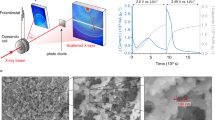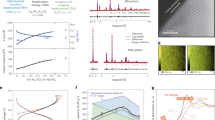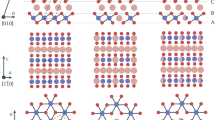Abstract
It has recently been shown that sulfur, a solid material in its elementary form S8, can stay in a supercooled state as liquid sulfur in an electrochemical cell. We establish that this newly discovered state could have implications for lithium–sulfur batteries. Here, through in situ studies of electrochemical sulfur generation, we show that liquid (supercooled) and solid elementary sulfur possess very different areal capacities over the same charging period. To control the physical state of sulfur, we studied its growth on two-dimensional layered materials. We found that on the basal plane, only liquid sulfur accumulates; by contrast, at the edge sites, liquid sulfur accumulates if the thickness of the two-dimensional material is small, whereas solid sulfur nucleates if the thickness is large (tens of nanometres). Correlating the sulfur states with their respective areal capacities, as well as controlling the growth of sulfur on two-dimensional materials, could provide insights for the design of future lithium–sulfur batteries.
This is a preview of subscription content, access via your institution
Access options
Access Nature and 54 other Nature Portfolio journals
Get Nature+, our best-value online-access subscription
$29.99 / 30 days
cancel any time
Subscribe to this journal
Receive 12 print issues and online access
$259.00 per year
only $21.58 per issue
Buy this article
- Purchase on Springer Link
- Instant access to full article PDF
Prices may be subject to local taxes which are calculated during checkout




Similar content being viewed by others
Data availability
The data that support the plots within this paper and other findings of this study are available from the corresponding author upon reasonable request.
References
Bruce, P. G., Freunberger, S. A., Hardwick, L. J. & Tarascon, J.-M. Li–O2 and Li–S batteries with high energy storage. Nat. Mater. 11, 19–29 (2012).
Seh, Z. W., Sun, Y., Zhang, Q. & Cui, Y. Designing high-energy lithium–sulfur batteries. Chem. Soc. Rev. 45, 5605–5634 (2016).
Zheng, G. et al. Amphiphilic surface modification of hollow carbon nanofibers for improved cycle life of lithium sulfur batteries. Nano Lett. 13, 1265–1270 (2013).
Yao, H. et al. Improving lithium–sulphur batteries through spatial control of sulphur species deposition on a hybrid electrode surface. Nat. Commun. 5, 3943 (2014).
Wang, H. et al. High electrochemical selectivity of edge versus terrace sites in two-dimensional layered MoS2 materials. Nano Lett. 14, 7138–7144 (2014).
Liu, N. et al. Direct electrochemical generation of supercooled sulfur microdroplets well below their melting temperature. Proc. Natl Acad. Sci. USA 116, 201817286–201817770 (2019).
Nelson, J. et al. In operando X-ray diffraction and transmission X-ray microscopy of lithium sulfur batteries. J. Am. Chem. Soc. 134, 6337–6343 (2012).
Zhang, L., Sun, D., Feng, J., Cairns, E. J. & Guo, J. Revealing the electrochemical charging mechanism of nanosized Li2S by in situ and operando X-ray absorption spectroscopy. Nano Lett. 17, 5084–5091 (2017).
Zhang, L. et al. The synergetic interaction between LiNO3 and lithium polysulfides for suppressing shuttle effect of lithium-sulfur batteries. Energy Storage Mater. 11, 24–29 (2018).
Wu, Y. & Liu, N. Visualizing battery reactions and processes by using in situ and in operando microscopies. Chem 4, 438–465 (2018).
Stephenson, T., Li, Z., Olsen, B. & Mitlin, D. Lithium ion battery applications of molybdenum disulfide (MoS2) nanocomposites. Energy Environ. Sci. 7, 209–231 (2013).
Ghazi, Z. A. et al. MoS2/Celgard separator as efficient polysulfide barrier for long‐life lithium–sulfur batteries. Adv. Mater. 29, 1606817 (2017).
Lei, T. et al. Multi‐functional layered WS2 nanosheets for enhancing the performance of lithium–sulfur batteries. Adv. Energy Mater. 7, 1601843 (2017).
Seh, Z. W. et al. Two-dimensional layered transition metal disulphides for effective encapsulation of high-capacity lithium sulphide cathodes. Nat. Commun. 5, 5017 (2014).
Babu, G., Masurkar, N., Salem, Al. H. & Arava, L. M. R. Transition metal dichalcogenide atomic layers for lithium polysulfides electrocatalysis. J. Am. Chem. Soc. 139, 171–178 (2016).
Zhang, Q. et al. Understanding the anchoring effect of two-dimensional layered materials for lithium–sulfur batteries. Nano Lett. 15, 3780–3786 (2015).
Wang, H. et al. Graphene-wrapped sulfur particles as a rechargeable lithium–sulfur battery cathode material with high capacity and cycling stability. Nano Lett. 11, 2644–2647 (2011).
Ji, L. et al. Graphene oxide as a sulfur immobilizer in high performance lithium/sulfur cells. J. Am. Chem. Soc. 133, 18522–18525 (2011).
Chen, H. et al. High‐quality graphene microflower design for high‐performance Li–S and Al‐ion batteries. Adv. Energy Mater. 7, 1700051 (2017).
Su, D., Cortie, M. & Wang, G. Fabrication of N‐doped graphene–carbon nanotube hybrids from Prussian blue for lithium–sulfur batteries. Adv. Energy Mater. 7, 1602014 (2017).
Choi, S. et al. WO3 nanolayer coated 3D-graphene/sulfur composites for high performance lithium/sulfur batteries. J. Mater. Chem. A 7, 4596–4603 (2019).
Sun, J. et al. Entrapment of polysulfides by a black-phosphorus-modified separator for lithium-sulfur batteries. Adv. Mater. 28, 9797–9803 (2016).
Nims, C., Cron, B., Wetherington, M., Macalady, J. & Cosmidis, J. Low frequency Raman spectroscopy for micron-scale and in vivo characterization of elemental sulfur in microbial samples. Sci. Rep. 9, 1–12 (2019).
Pascal, T. A. et al. X-ray absorption spectra of dissolved polysulfides in lithium–sulfur batteries from first-principles. J. Phys. Chem. Lett. 5, 1547–1551 (2014).
Levin, B. D. A. et al. Characterization of sulfur and nanostructured sulfur battery cathodes in electron microscopy without sublimation artifacts. Microsc. Microanal. 23, 155–162 (2017).
Kim, H. et al. In situ TEM observation of electrochemical lithiation of sulfur confined within inner cylindrical pores of carbon nanotubes. Adv. Energy Mater. 5, 1501306 (2015).
Hamada, S., Nakazawa, Y. & Shirai, T. Nucleation in liquid sulfur droplets. Bull. Chem. Soc. Jpn. 43, 3096–3101 (2006).
Mugele, F. & Baret, J.-C. Electrowetting: from basics to applications. J. Phys.: Condens. Matter 17, R705–R774 (2005).
Pollack, M. G., Fair, R. B. & Shenderov, A. D. Electrowetting-based actuation of liquid droplets for microfluidic applications. Appl. Phys. Lett. 77, 1725–1726 (2000).
Yang, Y., Zheng, G. & Cui, Y. A membrane-free lithium/polysulfide semi-liquid battery for large-scale energy storage. Energy Environ. Sci. 6, 1552–1558 (2013).
Ravel, B. & Newville, M. ATHENA, ARTEMIS, HEPHAESTUS: Data Analysis for X-Ray Absorption Spectroscopy Using IFEFFIT. J. Synchrotron Radiat. 12, 537–541 (2005).
Plimpton, S. Fast parallel algorithms for short-range molecular dynamics. J. Comput. Phys. 117, 1–19 (1995).
Sresht, V. et al. Quantitative modeling of MoS2–solvent interfaces: predicting contact angles and exfoliation performance using molecular dynamics. J. Phys. Chem. C. 121, 9022–9031 (2017).
Rajput, N. N. et al. Elucidating the solvation structure and dynamics of lithium polysulfides resulting from competitive salt and solvent interactions. Chem. Mater. 29, 3375–3379 (2017).
Merlet, C. et al. On the molecular origin of supercapacitance in nanoporous carbon electrodes. Nat. Mater. 11, 306–310 (2012).
Wang, Z., Yang, Y., Olmsted, D. L., Asta, M. & Laird, B. B. Evaluation of the constant potential method in simulating electric double-layer capacitors. J. Chem. Phys. 141, 184102 (2014).
Laturia, A., Van de Put, M. L. & Vandenberghe, W. G. Dielectric properties of hexagonal boron nitride and transition metal dichalcogenides: from monolayer to bulk. npj 2D Mater. Appl. 2, 4106 (2018).
Acknowledgements
We acknowledge support from the Department of Energy, Office of Basic Energy Sciences, Division of Materials Science and Engineering under contract DE-AC02-76SF00515. Part of this work was performed at the Stanford Nano Shared Facilities (SNSF) and Stanford Nanofabrication Facilities (SNF), supported by the National Science Foundation under award ECCS-1542152. R.A.V. acknowledges support from the National Academy of Sciences Ford Foundation Fellowship and the National Science Foundation Graduate Research Fellowship Program (NSF GRFP, grant number: DGE – 1656518). We acknowledge C. Su and J. Li from MIT for performing the DFT calculations. A.Y. acknowledges D. Zakhidov for his assistance with polarized Raman measurements and Y. Ye, Z. Wang and R. Xu for helpful discussions.
Author information
Authors and Affiliations
Contributions
A.Y. and Y.C. conceived and designed the experiments. A.Y. and G.Z. carried out device fabrication, imaging and electrochemical measurements. X.K. and J.Q. performed MD simulations. R.A.V. performed TEM characterizations. A.P. performed COMSOL simulations. X.Z. and S.F. performed in situ XAS measurements. Y.W., C.-L.W. and B.L. assisted in material preparation. X.Y., H.C., Y.X., D.C. and Y.L. assisted in electrochemical measurements. H.Y.H., S.C. and Y.C. supervised the project and all authors contributed to data discussions. A.Y. and Y.C. analysed the data and wrote the paper with input from all authors.
Corresponding author
Ethics declarations
Competing interests
The authors declare no competing interests.
Additional information
Peer review information Nature Nanotechnology thanks Yuyan Shao, Guoxiu Wang and Reza Shahbazian-Yassar for their contribution to the peer review of this work.
Publisher’s note Springer Nature remains neutral with regard to jurisdictional claims in published maps and institutional affiliations.
Supplementary information
Supplementary Information
Supplementary Figs. 1-21 and Table 1.
Supplementary Video 1
Sulfur generation on MoS2 shows distinct growth behaviors on the basal plane and the edges. Specifically, liquid sulfur droplets were generated on the basal plane of the MoS2 while solid sulfur crystal was generated on the edges of the MoS2 flake. Play speed is 3× of the actual speed.
Supplementary Video 2
Cryogenic electron microscopy (Cryo-EM) Selected Area Electron Diffraction (SAED) of solid sulfur indicates its high crystallinity. The sample was tilted between -30° and 30°. Play speed is 5× of the actual speed.
Supplementary Video 3
Liquid and solid sulfur generation on the edges of 2D flake. Liquid droplets were observed on the edges at the initial stage and quickly turned into solid by the emerging crystals from the edges. Play speed is 5× of the actual speed.
Supplementary Video 4
Sulfur generation on monolayer MoS2. Liquid droplets were dynamically generated on monolayer MoS2 without crystallization. The MoS2 flake in the middle was not connected to the Ti electrode, so no sulfur was generated. Play speed is 20× of the actual speed.
Supplementary Video 5
Liquid sulfur generation on MoS2 window. The edges of the MoS2 flake were completely covered to suppress crystal growth. Play speed is 10× of the actual speed.
Supplementary Video 6
Solid sulfur generation on MoS2 window. The edges of the MoS2 flake were partially left open to initiate crystal growth. Play speed is 10× of the actual speed.
Rights and permissions
About this article
Cite this article
Yang, A., Zhou, G., Kong, X. et al. Electrochemical generation of liquid and solid sulfur on two-dimensional layered materials with distinct areal capacities. Nat. Nanotechnol. 15, 231–237 (2020). https://doi.org/10.1038/s41565-019-0624-6
Received:
Accepted:
Published:
Issue Date:
DOI: https://doi.org/10.1038/s41565-019-0624-6
This article is cited by
-
Encapsulating MoS2-nanoflowers conjugated with chitosan oligosaccharide into electrospun nanofibrous scaffolds for photothermal inactivation of bacteria
Journal of Nanostructure in Chemistry (2024)
-
Machine-learning-assisted design of a binary descriptor to decipher electronic and structural effects on sulfur reduction kinetics
Nature Catalysis (2023)
-
Unveiling Xanthine Presence in Rohu Fish Using Ag+-Doped MoS2 Nanosheets Through Electrochemical Analysis
Applied Biochemistry and Biotechnology (2023)
-
Rapid construction of highly-dispersed cobalt nanoclusters embedded in hollow cubic carbon walls as an effective polysulfide promoter in high-energy lithium-sulfur batteries
Nano Research (2022)
-
Selenium vacancies enable efficient immobilization and bidirectional conversion acceleration of lithium polysulfides for advanced Li-S batteries
Nano Research (2022)



